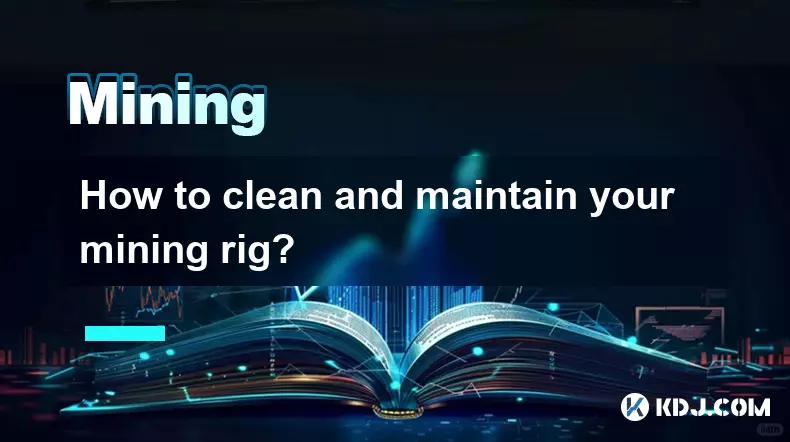-
 bitcoin
bitcoin $111743.690167 USD
0.54% -
 ethereum
ethereum $3950.699791 USD
0.55% -
 tether
tether $1.000164 USD
-0.01% -
 xrp
xrp $2.611685 USD
2.58% -
 bnb
bnb $1122.616845 USD
1.30% -
 solana
solana $193.462394 USD
-0.26% -
 usd-coin
usd-coin $0.999872 USD
-0.03% -
 dogecoin
dogecoin $0.196092 USD
-1.61% -
 tron
tron $0.296693 USD
-0.41% -
 cardano
cardano $0.652995 USD
-0.60% -
 hyperliquid
hyperliquid $44.316120 USD
12.98% -
 chainlink
chainlink $17.906269 USD
0.05% -
 ethena-usde
ethena-usde $0.999193 USD
-0.02% -
 stellar
stellar $0.326600 USD
1.70% -
 bitcoin-cash
bitcoin-cash $513.235984 USD
1.57%
How to build a crypto mining rig step-by-step?
Choose high-performance GPUs like the RTX 3090 or RX 6800 XT, pair with a multi-GPU motherboard, reliable PSU, and efficient cooling for optimal mining rig performance.
Oct 26, 2025 at 08:18 am

Choosing the Right Hardware Components
1. Select a high-performance graphics processing unit (GPU) that offers strong hash rates for your chosen cryptocurrency. Models like the NVIDIA RTX 3090 or AMD RX 6800 XT are popular due to their efficiency and power in handling complex mining algorithms.
2. Choose a motherboard that supports multiple GPUs, such as the ASRock H110 Pro BTC+ or MSI B450 Tomahawk, which allow expansion slots necessary for multi-GPU configurations.
3. Use a reliable central processing unit (CPU), though mining primarily relies on GPU power. A basic but stable CPU like the Intel Celeron G3900 is sufficient for system operations.
4. Install adequate RAM—8GB of DDR4 memory ensures smooth multitasking between mining software and background processes.
5. Pick a power supply unit (PSU) with enough wattage to support all components. For rigs with six GPUs, a 1200W to 1600W 80 Plus Gold PSU is recommended to maintain stability and prevent overloads.
Assembling the Mining Rig
1. Set up the motherboard on a non-conductive surface or inside a dedicated mining frame. Secure it properly to avoid short circuits.
2. Insert the CPU into its socket and attach the cooling fan. Apply thermal paste if not pre-applied on the heatsink.
3. Install the RAM sticks into their designated slots, pressing down firmly until they click into place.
4. Mount each GPU using PCIe riser cables. These extenders connect the GPUs to the motherboard and allow better spacing and airflow.
5. Connect all power cables from the PSU to the motherboard, CPU, and each GPU. Double-check connections to ensure no loose wires that could cause interruptions during operation.
Proper ventilation and cable management significantly reduce overheating risks and improve long-term rig performance.
Installing Software and Configuring Mining Operations
1. Install a lightweight operating system optimized for mining, such as HiveOS or SimpleMining OS. These systems boot from USB drives and manage hardware efficiently with minimal resource usage.
2. Once the OS is running, configure network settings to establish an internet connection. This step is crucial for communicating with mining pools.
3. Choose a mining pool based on your target cryptocurrency. For Ethereum, options include Ethermine or F2Pool; for Ravencoin, consider TeamRedMiner or Nanopool.
4. Download and install the appropriate mining software—T-Rex Miner for NVIDIA cards or PhoenixMiner for AMD setups—and input your wallet address and pool server details.
5. Adjust overclocking settings through the BIOS or mining software interface to optimize power consumption versus hash rate. Monitor temperatures closely to avoid damaging hardware.
Monitoring and Maintaining Performance
1. Regularly check dashboard statistics provided by your mining OS to track uptime, rejected shares, and temperature levels across all GPUs.
2. Clean dust buildup from fans and heat sinks every two weeks to maintain optimal cooling. Use compressed air to avoid physical damage.
3. Update firmware and mining software periodically to benefit from bug fixes, security patches, and improved efficiency.
4. Rotate GPUs occasionally to balance wear and tear, especially in large-scale operations where consistent output is critical.
5. Keep spare parts like riser cables and PSUs on hand to minimize downtime in case of sudden failures.
Frequently Asked Questions
What is the best cryptocurrency to mine with a GPU rig?Ethereum Classic, Ravencoin, and Ergo are currently among the most profitable options for GPU miners due to their resistance to ASIC dominance and active development communities.
How much electricity does a typical mining rig consume?A six-GPU rig can draw between 800W to 1200W under full load. Actual consumption depends on GPU models, overclocking settings, and ambient temperature.
Can I use consumer-grade GPUs for professional mining operations?Yes, many operators use retail GPUs, though continuous 24/7 operation may shorten lifespan. Proper cooling and undervolting can mitigate some risks.
Is it necessary to use a separate computer to control the mining rig?No. Modern mining OS platforms run independently on the rig itself and offer web-based dashboards accessible from any device on the same network.
Disclaimer:info@kdj.com
The information provided is not trading advice. kdj.com does not assume any responsibility for any investments made based on the information provided in this article. Cryptocurrencies are highly volatile and it is highly recommended that you invest with caution after thorough research!
If you believe that the content used on this website infringes your copyright, please contact us immediately (info@kdj.com) and we will delete it promptly.
- Essex Post Office, 5p Coins, and King Charles: A Royal Mint Revelation!
- 2025-10-23 10:30:16
- Waymo's Newark Airport AV Tests: Alphabet's AI Gamble Pays Off?
- 2025-10-23 10:30:16
- King Charles 5p Coins: A Royal Flush in Your Pocket?
- 2025-10-23 10:35:18
- Solana, Crypto Advisory, and Forward Industries: A New York Minute on the Future of Finance
- 2025-10-23 08:51:22
- MAGACOIN: Ethereum Whales Dive into the Hottest Presale of 2025
- 2025-10-23 08:51:22
- Kadena's End of the Road? KDA Token Plummets Amid Project Abandonment
- 2025-10-23 08:55:34
Related knowledge

How to build a crypto mining rig step-by-step?
Oct 26,2025 at 08:18am
Choosing the Right Hardware Components1. Select a high-performance graphics processing unit (GPU) that offers strong hash rates for your chosen crypto...

How to set up a Chia (XCH) farming plot?
Oct 26,2025 at 03:20am
Understanding Chia Farming and Its Requirements1. Chia (XCH) operates on a unique consensus mechanism known as Proof of Space and Time, differing from...

How to set power limits for your GPUs?
Oct 26,2025 at 08:00am
Understanding Market Volatility in the Crypto Space1. Cryptocurrency markets are known for their extreme price fluctuations, often driven by sentiment...

How to clean and maintain your mining rig?
Oct 26,2025 at 08:01pm
Cleaning Dust and Debris from Your Mining Rig1. Power down the mining rig completely and disconnect it from all power sources to ensure safety during ...

How to use a VPN for crypto mining?
Oct 25,2025 at 06:01pm
Understanding the Role of a VPN in Crypto Mining1. A Virtual Private Network (VPN) creates an encrypted tunnel between your device and a remote server...

How to calculate your mining farm's power consumption?
Oct 26,2025 at 07:54pm
Understanding the Components of Power Consumption in a Mining Farm1. Every mining farm relies on application-specific integrated circuit (ASIC) machin...

How to build a crypto mining rig step-by-step?
Oct 26,2025 at 08:18am
Choosing the Right Hardware Components1. Select a high-performance graphics processing unit (GPU) that offers strong hash rates for your chosen crypto...

How to set up a Chia (XCH) farming plot?
Oct 26,2025 at 03:20am
Understanding Chia Farming and Its Requirements1. Chia (XCH) operates on a unique consensus mechanism known as Proof of Space and Time, differing from...

How to set power limits for your GPUs?
Oct 26,2025 at 08:00am
Understanding Market Volatility in the Crypto Space1. Cryptocurrency markets are known for their extreme price fluctuations, often driven by sentiment...

How to clean and maintain your mining rig?
Oct 26,2025 at 08:01pm
Cleaning Dust and Debris from Your Mining Rig1. Power down the mining rig completely and disconnect it from all power sources to ensure safety during ...

How to use a VPN for crypto mining?
Oct 25,2025 at 06:01pm
Understanding the Role of a VPN in Crypto Mining1. A Virtual Private Network (VPN) creates an encrypted tunnel between your device and a remote server...

How to calculate your mining farm's power consumption?
Oct 26,2025 at 07:54pm
Understanding the Components of Power Consumption in a Mining Farm1. Every mining farm relies on application-specific integrated circuit (ASIC) machin...
See all articles










































































